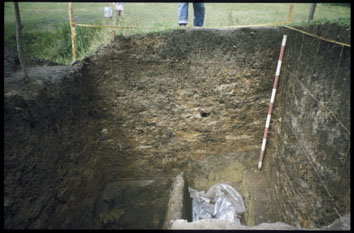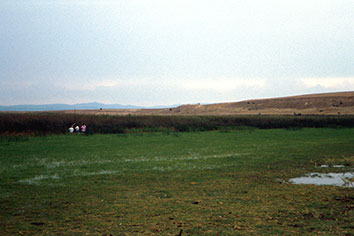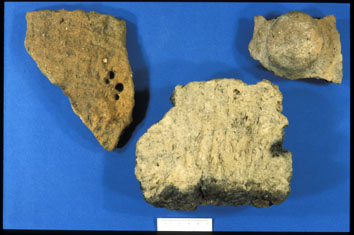Research
Research Field – European prehistory
Thirty years’ active research in the European Mesolithic, Neolithic and Copper Age, with special reference to South East Europe; application of new theoretical approaches to Balkan later prehistoric communities, including settlement studies, social power, social space, landscape archaeology, demography, mortuary analysis, material culture studies, gender archaeology, structure-agency problems, cognitive archaeology, fragmentation and strategies of categorisation. Integration of archaeological science with fieldwork and excavation data. My research interests fall into three groupings, all of which are linked by an underlying investigation of prehistoric social structures.

A: Landscape Archaeology
A1: Neothermal Dalmatia Project
Neothermal Dalmatia Project: Ljubljana Iron Age hillfort

Co-director (with Professor Šime Batovic, Zadar) of a five-year interdisciplinary Anglo-Croatian programme of fieldwalking, excavation and palaeo-environmental reconstructions, which resulted in over 30 publications and a synthetic monograph (2.1, 5.1 and 5.3). The emphasis on inter-disciplinary landscape research led to collaboration with historians, ethnographers, soil scientists, geomorphologists, palynologists, botanists, archaeo-zoologists, metallurgists and dry-stone wall builders.
A2: Upper Tisza Project


Co-director (with Dr. József Laszlovszky, Budapest) of this six-year interdisciplinary Anglo-Hungarian landscape archaeological programme based upon GIS from the outset. Inter-disciplinary collaborations include research on DNA (Dr. Keri Brown, UMIST), stable isotope and physical anthropology (Dr. Beth Rega, California), soil science, geo-archaeology and palaeo-hydrology (as in Dalmatia). The project has seen one part of a planned e-Book and ten interim publications so far. Four conventional monographs have been published with Archaeopress: (2) Lowland Field Survey Block 2 (5.29); (3) Upland Field Survey Block 3 (5.30); (4) Excavations at the Neolithic Site of Polgár-10 (5.31); (5) Excavations at the Neolithic & Bronze Age Site of Regéc-95 (5.32). The sixth volume (‘The Chipped, Ground & Polished Stone Assemblages of North-East Hungary’) will be completed by 2012. A conventional synthetic monograph is planned for 2014 to summarize the results.
A3: The prehistoric exploitation of salt in Romania and Bulgaria

Co-director (with Dr. Dan Monah [Romania] and Dr. B. Gaydarska [Bulgaria]) of a project seeking to locate prehistoric salt sources, assess alternative methods of salt production, discover analytical methods of characterizing salt sources in pottery and bone, and define the range of salt exchange through such analyses. Trial excavations of Neolithic and Chalcolithic sites near known Moldavian salt sources have produced important results: Lunca – Poiana Slatinei is currently the world’s oldest salt production site, while Siliste-Prohozesti is a seasonal Cucuteni site for hide-treatment using brine. In Bulgaria, where no prehistoric salt exploitation sites were known before our work, five super-salty coastal limans and three inland brine spring sources have been identified. Three preliminary reports published (4.35, 5.5 & 5.6), as well as an edited volume (3.7) and three articles (5.8, 5.20 & 5.21). Work in progress includes the Early Neolithic pottery report from Lunca (8.3).


A4: Megaliths and cultural identity in Bulgaria

The ‘Forest of Stones’ Project focuses on the ‘Carnacs’ of South East Europe – a poorly-understood class of monuments found in the South East Balkans whose dating has posed severe problems. The ‘forests’ in question are composed of often massive groups of undressed standing stones that play a significant but poorly defined role in inter-cultural interactions over several centuries. The project has sought to offer a truly inter-disciplinary approach to the issues of community identity and landscape politics raised by these frequently huge standing stones, which dominate parts of the South East Balkan landscape in the same way that Neolithic menhirs and stone rows dominate parts of the Breton landscape in North West Europe. Two trial excavations at the cemeteries of Gorno Novo Selo, near Chirpan, and Bozhurka, near Targovishte, as well as on a measured survey of the Kirikköy site in Turkish Thrace (5.13).

Our research has demonstrated the following: (1) Sites comprise groups of between 20 and 2,000 standing stones; (2) Standing stones range in height from as little as 20cm to as much as 3 metres, often making a remarkable visual impression; (3) The main current distribution of the standing stones is in Eastern Greek Thrace, Turkish Thrace and the Eastern half of Bulgaria; (4) Higher monument densities occur in upland zones; (5) The time-span of the standing stones is still to be defined more closely, with a starting date perhaps no earlier than the Ottoman conquest and their continued use for Muslim burials in some villages into the 1960s; (6) The primary function of the standing stones is as paired grave markers; (7) In the sites associated with undressed stones, there is enormous variability in grave morphology; (8) There can also be great variability in the association of different types of grave on one and the same site; and (9) Undressed standing stones formed an inter-cultural marker over a long period.
There are three key issues for the publication of this research: the origins of such a mortuary practice and tradition, the agglomeration of undressed stones in often large cemeteries to create a new and dominant landscape feature, and the mechanisms by which the ‘Forests of Stones’ were adopted in a range of differing faith communities.
The research has been funded by the British Academy, the Bulgarian Academy of Sciences, the Society of Antiquries of London and Durham University. Negotiations are currently proceeding for publication with Oxford University Press (8.4).
A5: The “Climax Neolithic Settlements Project”

The “Climax Neolithic Settlements Project” takes as its starting-point the Tripolye mega-sites of Ukraine – the largest sites in 4th millennium BC Europe, termed ‘proto-urban’ by local archaeologists, and the only exception to Roland Fletcher’s limits of agrarian settlement growth. The project objective is to understand how and why Tripolye sites expanded in this unprecedented way, using a structured comparison with Hungarian 5th millennium Lengyel sites, which developed a strikingly divergent settlement trajectory from a similar early farming base in a broadly comparable loessland environment. In summer 2009, a preliminary season co-directed by Dr. Mikhail Videiko and myself focussed on the 220-ha. mega-site of Nebelivka, Kirovograd domain, enabling the production of a 15-ha. geophysics plot with over 50 burnt structures and a small number of unburnt structures, as well as pits and other anomalies. Coring of burnt structures was successful in recovering organically-rich daub for direct 14-C dating. Early article on the provosion of salt to Tripolye mega-sites (5.8). A preliminary note is planned for ‘Antiquity’ 2011 (8.5). A general article on Tripolye mega-sites has also been published (5.37).



B: Archaeological Science
B1: The Varna cemetery

It is an astonishing truth that the first AMS 14-C dates for the Varna cemetery—one of the key sites in world prehistory—were published as late as 2007! The Keeper of Prehistory at Varna Museum, Dr. Vladimir Slavchev, is collaborating with Durham (Drs. John Chapman and Bisserka Gaydarska) and the RLAHA at Oxford to run an additional 50 samples for AMS dating and isotopic dietary analysis. The first set of 14 dates showed a tight grouping at 4750–4550 BC, with no obvious spatial trends in cemetery layout (all areas had graves with early dates) and a possible sign of ‘richer’ graves being dated earlier than ‘poorer’ graves. Three articles have been published on the first run of dates (5.16, 5.18 & 5.23), with one further study in press (7.6); work is in progress on the major final report (8.1). A general article on the Varna cemetery has also been published (5.37).

The Durham group has also collaborated with Varna Historical Museum on the shell ornaments at the Varna cemetery, which included fragmentation and re-fitting analyses of the Spondylus / Glycymeris shell rings. Two preliminary reports published (4.39, 5.22), with two in press (7.3: cf. 7.5 for Dimini). A comprehensive study of all of the shell ornaments is in progress for publication in the final Varna monograph (8.1). This research has led to an in-press European survey of Spondylus exchange network (7.7)
B2: The human impact of farming in Central and South East Europe
In comparison with NW Europe, where there is significant human farming from early farmers, the far smaller number of pollen diagrams from SE Europe purport to show very little impact. This is probably because the pollen coring sites were remote from settlements with documented, 14C-dated early farming. Three coring sites have been chosen for their proximity to archaeological settlement: Göl Baba (Turkish Thrace), Ezero (SE Bulgaria) and Sarló-hát (NE Hungary) (for preliminary reports, see 5.11 & 5.12). The Sarló-hát cores show excellent correlations for human impact with the dates for the archaeological sites 30m from the coring site – one Middle Neolithic site and one Earlier Bronze Age site. It is interesting that, in two periods where no surface material has been found in the micro-region, there are nonetheless huge impacts (Late Neolithic arable impact; Early Iron Age pastoral with some arable impact). The results from the other two cores were disappointing insofar as the summer temperatures at the time of Neolithic and Chalcolithic occupation were too high to permit all-year-round sedimentation and so the pollen cores have hiatuses at the critical period. Nonetheless, the Ezero core has a well-preserved sequence for the Early Holocene (5.24) and the Late Holocene (the latter coeval with Late Bronze Age, Iron Age and Roman settlement) (5.26), while the Göl Baba core has a well preserved Late Holocene sequence. The Sarló-hát core also shows the persistence of forest steppe in the Early Holocene of the Alföld Plain (5.38).




B3: Dairy consumption in Balkan prehistory

The NERC-funded Project “Milk residues as direct evidence for the origins of dairying in Europe” (grant-holder: Dr. M. Collins, York) invited me to be their archaeological consultant for SE Europe, to identify key problems and find the most appropriate samples. The research has successfully documented traces of dairying on ceramics from early farming sites in SE Europe and also questioned the function of the famous Copper Age “milk-jugs” for ever holding milk! Two published papers (5.10 and 5.14).
C1: Societies and Material culture
C1: Fragmentation studies


The 2000 monograph was a ground-breaking summary of processes of fragmentation of objects and people and the implications for the understanding of social practices in the Balkan Mesolithic, Neolithic and Copper Age (1.2). The key observation was that many types of objects were deliberately broken prior to the end of their use-life. Explanations derived from ethnography and material culture studies are advanced to indicate the dynamic potential of broken things to influence the creation and maintenance of social relationships. However, this research was focused at a general level (4.27, 4.28, 4.29, 4.33, 4.39). In a second book (2.3), intra-site re-fitting experiments have been carried on four completely excavated sites & the Varna and Durankulak cemeteries and the Dimini Late Neolithic settlement (to re-fit shell rings) and the Dolnoslav tell (figurines). These results are placed in a general context of what deliberate fragmentation means for the creation of personhood, the changing uses of material culture and its categorisation and the significance of enchained relations at the inter- as well as the intra-site level. Subsequent research has sought to embed fragmentation theory in wider contexts, both conceptually (e.g., landscape studies: 4.43 & 4.47; exchange studies: 4.46) and temporally (e.g., the Early Palaeolithic: 5.35).

C2: Mortuary studies

As part of my interest in structure-agency questions, I developed an intermediate scale of cemetery analysis – the row or line of graves (between the whole cemetery and the individual grave). This enabled a much more dynamic view of cemetery developments than is usually possible, leading also to global and local rules guiding mortuary practice at four Hungarian prehistoric sites. Published monograph (2000) (1.3, 4.12, 4.19 and 4.25). The application of the fragmentation premise to mortuary remains led to a review of ‘deviant’ and ‘unusual’ burials in the Balkan Neolithic and Copper Age (5.36)
C3: The aesthetics of colour, brilliance and geometric form

Earlier research on colour in Balkan prehistory (published as book chapters in 4.34 & 4.37) stimulated a more general approach to aesthetics in these societies. I showed that aesthetic principles as applied to material culture were based not only on colour but also on brilliance, as well as on geometric order and the importance of exotic objects from far-flung sources. After three papers based upon the aesthetics of material culture in different periods (4.41, 4.42 & 4.44), two more general papers sought to integrate geometric order into prehistoric aesthetics, using examples of high-precision manufacture, one published (5.28) and one in press (7.9). I have contributed to the editing of a volume on the properties of stone and its significance for objects and monuments (5.34).



C4: The Early Neolithic pottery assemblage from Schela Cladovei


As a specialist consultant on the Anglo-Romanian Schela Cladovei Project (Mr. C. Bonsall & Dr. V. Boroneant), I have completed a report on the Early Neolithic pottery assemblage excavated in the 1990s. This study of 8,000 sherds is the most detailed ever produced for Neolithic pottery and explores production and use-life variables, as well as more traditional facets. Book chapter prepared for publication (7.1).
C5: Exchange, personhood and enchainment



Another significant aspect of the fragmentation premise concerns the basis of prehistoric exchange and trade in enchained relations across the landscape and the multi-facetted creation of personhood. An extended consideration of these themes was published in a review of exchange at the European level in the Neolithic, Chalcolithic and Bronze Age (4.46), while the discovery of an unpublished hoard of shell fragments and other objects in an amphora led to the elaboration of an approach to things based upon object-biographies, personhood, enchainment and accumulation in the Balkan Chalcolithic context (5.9; cf. also 4.44). A new research monograph has been published on the site of multi-period site of Orlovo, in South East Bulgaria, in which an extraordinarily rich surface collection has yielded fascinating insights into the relationship between the creation of personhood and ornaments, polished stone axes and clay figurines (5.33). A further paper (7.10) has begun to link the importance of different types of person with the advent of farming and, later, of metallurgy, to the development of new pathways towards personhood.


